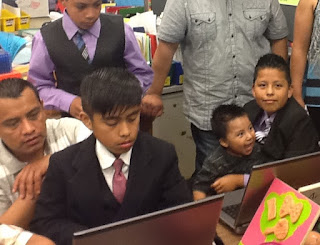By Ashley Coblentz and Jackie Moreno
 The beginning of the fall is always hectic - teachers are frantically trying to
finish bulletin boards, and parents are starting to pop into classrooms. In the
midst of all this, the most essential systems of support are being established.
There is a lot going on, but what are key steps that ESL and bilingual teachers
can take early on that will make a difference for their students throughout the
year?
The beginning of the fall is always hectic - teachers are frantically trying to
finish bulletin boards, and parents are starting to pop into classrooms. In the
midst of all this, the most essential systems of support are being established.
There is a lot going on, but what are key steps that ESL and bilingual teachers
can take early on that will make a difference for their students throughout the
year?
Here are some ideas:
Make sure all teachers know about the language needs in their classrooms
One of the WIDA tools that we find the most
helpful in the fall is the Can Do Name Chart. This chart is an at a glance resource that helps teachers better
understand the language needs of students in the areas of listening, speaking,
reading and writing. Share this valuable information with other teachers early
on to help frame students from an asset-based perspective.
ESL and bilingual teachers are experts in differentiating
lessons for ELLs, but in many schools students only work directly with these
teachers for a small portion of their day or even week. If all teachers have a
deeper understanding of what their students can do, it will have a greater
impact on their daily instruction.
Be a central part of team
meetings
Although working with small groups is very
important, finding ways to co-plan and co-teach with other teachers can have an
even bigger impact by helping make more content accessible to a wider range of
language learners throughout the school day. ESL and bilingual teachers’
understanding of how students develop language is critical to their success, so
make sure you have the chance to offer input and impact instruction during
planning time.
Early on you can suggest to your team that
collectively you might study your planning process and notice if the needs of
ELLs are add-ons or if they are an integral part of how the team plans. From
there you can have reflective conversations, make adjustments and set goals
together as needed. Even though these conversations can feel a little
uncomfortable at times, it is so much easier to have them in the fall from a
proactive place then from a place of frustration later in the year. And of
course, for the students the sooner this is in place, the better.
Place language learners in
the center
When it comes to school-wide professional
development, make sure that the needs of language learners are not an
after-thought at your school. Be an advocate and ensure that the professional
development prioritizes these needs.
For example, if your school is offering PD on technology, partner with the technology coach and focus on tools
that serve as graphic, interactive or sensory supports for all students, but
are particularly beneficial for ELLs.
The best part about the fall is that it is a
fresh start for both students and teachers - take the opportunity to make this year the best yet!




